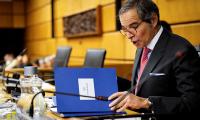Many Pakistanis, including the incumbent prime minister, speak nostalgically of a time when Pakistan was considered an economic success story in Asia and used to enjoy huge prestige on the international stage.
The halcyon days ended after three decades of the nation’s foundation and ever since Pakistan has slipped behind its peers in social and economic transformation. What’s worse is that the gap is getting wider and wider.
How was Pakistan was able to excel so spectacularly in a challenging environment at one time, and why is our country failing so abjectly now, while almost all countries in our neighbourhood steam ahead? This question interests barbers, television anchors and policymakers alike. In the absence of a serious policy debate, the past is often explained by praising some individuals and blaming others, while hope for the future is also pinned on some individuals or on divine help.
The World Bank has started a much-needed debate that is aimed at analyzing the reasons for Pakistan’s past performance and drawing scenarios for the future. The process was initiated with a well-researched publication, ‘Pakistan@100’, meant as a reference document. It aims to engage local researchers, citizens and various stakeholders in envisioning Pakistan at its centenary in 2047. The World Bank hopes to stir a debate on reforms and the political environment needed to address structural shortcomings.
For the last three to four decades, Pakistan has been caught in repeated boom-bust cycles, which often coincide with periods of generous foreign assistance or its withdrawal. Episodes of high growth alternate with periods of slow growth. According to the report, if Pakistan’s population growth rate of 2.4 percent over the past 20 years is factored in, its per capita growthrates have been below 2 percent on average since 2010.
The report finds a number of reasons for the problem of slow economic growth. Growth has declined because the country is not investing enough in either physical or human capital. Even these limited resources are not used in the most productive way due to misguided economic policies. The state is undermined due to a complex security environment and the connection between the state and the crony sectors of economy. Productivity is also hampered by weak public service provision in various areas.
Pakistan’s failure to change this situation provides another set of reasons stifling the nation’s economic development. Pakistan’s track record of implementing difficult reforms has been mixed as the country often focuses on seemingly more imminent crises. As 2018 came to a close, the cycle seemed to be repeating itself, with the PTI government busy in avoiding a macroeconomic crisis instead of the business of longer-term development.
The writers of the report believe that Pakistan has the potential to increase its per capita income almost fivefold and achieve upper middle-income status by its centenary in 2047. This optimistic scenario is based on the fact that Pakistan is gifted with a young and growing labour force, significant amounts of arable land, and geographic proximity to some of the largest and fastest growing economies of the world.
However, this scenario requires a deep-rooted economic transformation involving a boost to capital investment and significant improvements to health and education. It requires structural transformation that moves people from farms and low-value added services to highly productive, innovative and well-managed firms.
In order to realize this scenario, the report envisages Pakistan’s population growth below 1.2 percent by 2047. Currently, our population growth stands at 2.4 percent. Interestingly, most regional countries, including India, Bangladesh, Sri Lanka and Iran have already succeeded in bringing down their population growth to this level.
The report suggests that Pakistan should increase its spending on education from 2 percent of GDP to 5 percent while it should increase its spending on health from one percent to 2 percent. Last year, the leadership of almost all major political parties signed a reform agenda called the ‘Charter for Education’, committing to increase provincial and federal education spending to 4 percent of the GDP, supported by substantial governance reforms to ensure that the allocated funds are spent effectively and transparently. Due to budgetary constraints, this promise may remain unfulfilled in the near future.
In order to realize the goal of accumulation of physical capital, the report suggests Pakistan should collect tax revenues of 20 percent of GDP by 2030. Currently, Pakistan’s tax revenue is less than 13 percent of GDP. India already collects 22 percent of GDP. PM Imran Khan had promised to raise tax collection from Rs4000 billion to Rs8000 billion, which should be close to the target suggested by the report at the current level of GDP. However, under the new government, the growth in revenue generation has gone down and reforming the FBR remains a daunting challenge.
The report envisages improvement in Pakistan’s Doing Business ranking from 136 to 50 by 2023. Pakistan has started improving on this ranking after slipping down for almost a decade. The government has initiated a number of reforms in this area and substantial progress can be expected in the next few years.
The report also suggests completing the devolution of responsibilities and resources to local governments; streamlining Information and Communication Technology (ICT) initiatives to provide avenues for citizens to hold service providers accountable; and providing levers for citizens to sanction public officials and political leaders when policy and service delivery do not meet their expectations.
As the report warns, reform efforts in Pakistan have often failed because they challenge an existing equilibrium of power. A section of the elite succeeds in the capture of policy formulation, harming the economy and the public interest. The textile industry has worked against a reform of Pakistan’s Goods and Services Tax (GST) system to maintain a zero-rating of textile products. Similarly, the sugarcane lobby is politically connected and has influenced policy to maintain subsidies for the sector.
These beneficiary groups have developed a huge clout as they enter the political process directly, thus blurring the lines between political leaders and private interests. For example, the share of industrialists with a parliamentary mandate has doubled over the past 30 years.
Will Pakistan fail to rein in these interests and put people at the centre of the development agenda? As the report warns, the decisions over the next decade will determine Pakistan’s future. It raises questions that the country must debate and our policymakers must answer. Will Pakistan rise to the challenges ahead and transform its economy? Or will Pakistan continue with the mixed record of reform implementation, failing to address the key constraints to growth, while another generation of Pakistanis sees limited welfare improvements?
The writer is an anthropologist and development professional.
Email: zaighamkhan@yahoo.com
Twitter: @zaighamkhan
Data, today, defines how we make decisions with tools allowing us to analyse experience more precisely
But if history has shown us anything, it is that rivals can eventually unite when stakes are high enough
Imagine a classroom where students are encouraged to question, and think deeply
Pakistan’s wheat farmers face unusually large pitfalls highlighting root cause of downward slide in agriculture
In agriculture, Pakistan moved up from 48th rank in year 2000 to an impressive ranking of 15th by year 2023
Born in Allahabad in 1943, Saeeda Gazdar migrated to Pakistan after Partition







